 There is much interest in locally produced foods, but the federal, state, and local regulations can be confusing. This 5-page fact sheet is a “one-stop-shop” for Florida residents who want to sell meat from their own livestock and poultry. Written by Chad Carr, Jason Scheffler, Larry Eubanks, Ron Webb, Lee Cornman, Scotland Talley, and Steve Stiegler, and published by the UF Department of Animal Sciences, December 2014. (Photo: iStock/Thinkstock.com)
There is much interest in locally produced foods, but the federal, state, and local regulations can be confusing. This 5-page fact sheet is a “one-stop-shop” for Florida residents who want to sell meat from their own livestock and poultry. Written by Chad Carr, Jason Scheffler, Larry Eubanks, Ron Webb, Lee Cornman, Scotland Talley, and Steve Stiegler, and published by the UF Department of Animal Sciences, December 2014. (Photo: iStock/Thinkstock.com)
http://edis.ifas.ufl.edu/an316
Category: Agriculture
Facts about Farm to School
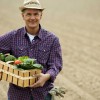 Farm to school is a nationwide program that improves the supply of fresh, local produce to schools by building relationships between local farmers and schools. Over the past 20 years, school districts in all 50 states have joined the F2S program and are purchasing items from local farmers. Recent requirements for more fruit and vegetables in the National School Lunch Programs have made the F2S program more popular than ever. The University of Florida is committed to the Farm to School program and is working closely with the Florida Department of Agriculture and Consumer Services to connect farmers to schools. This 3-page fact sheet was written by Samantha Ward, Lauren Headrick, and Karla Shelnutt, and published by the UF Department of Family Youth and Community Sciences, December 2014. (Photo: iStock/Thinkstock.com)
Farm to school is a nationwide program that improves the supply of fresh, local produce to schools by building relationships between local farmers and schools. Over the past 20 years, school districts in all 50 states have joined the F2S program and are purchasing items from local farmers. Recent requirements for more fruit and vegetables in the National School Lunch Programs have made the F2S program more popular than ever. The University of Florida is committed to the Farm to School program and is working closely with the Florida Department of Agriculture and Consumer Services to connect farmers to schools. This 3-page fact sheet was written by Samantha Ward, Lauren Headrick, and Karla Shelnutt, and published by the UF Department of Family Youth and Community Sciences, December 2014. (Photo: iStock/Thinkstock.com)
http://edis.ifas.ufl.edu/fy1450
The role of crop production practices and weather conditions in microbiological safety of tomatoes and peppers
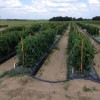 Salmonella and other human pathogens can contaminate produce at any stage from “farm to fork.” If we can better understand how production practices may make crops more or less susceptible to human pathogens we may be able to significantly reduce the number and severity of the produce-associated outbreaks. This 3-page fact sheet provides up-to-date information about tomato production practices and their relationships with Salmonella. Written by Massimiliano Marvasi, George Hochmuth, and Max Teplitski, and published by the UF Department of Soil and Water Science, December 2014. (Photo: Max Teplitski, UF/IFAS)
Salmonella and other human pathogens can contaminate produce at any stage from “farm to fork.” If we can better understand how production practices may make crops more or less susceptible to human pathogens we may be able to significantly reduce the number and severity of the produce-associated outbreaks. This 3-page fact sheet provides up-to-date information about tomato production practices and their relationships with Salmonella. Written by Massimiliano Marvasi, George Hochmuth, and Max Teplitski, and published by the UF Department of Soil and Water Science, December 2014. (Photo: Max Teplitski, UF/IFAS)
http://edis.ifas.ufl.edu/ss628
Impact of Tomato Varieties and Maturity State on Susceptibility of Tomatoes to Salmonella
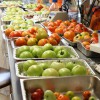 Non-typhoidal Salmonella has emerged as one of the problematic human pathogens associated with fresh produce, nuts, and complex foods containing them. Recent research shows that some varieties of plants are more “resistant” to colonization by the pathogens than others. This raises the intriguing possibility that cultivar selection could be used to identify crop varieties that may be less conducive to proliferation of human pathogens. This 3-page fact sheet provides up-to-date information about tomato production practices and their relationships with Salmonella. Written by Massimiliano Marvasi, George Hochmuth, and Max Teplitski, and published by the UF Department of Soil and Water Science, December 2014. (Photo: Max Teplitski, UF/IFAS)
Non-typhoidal Salmonella has emerged as one of the problematic human pathogens associated with fresh produce, nuts, and complex foods containing them. Recent research shows that some varieties of plants are more “resistant” to colonization by the pathogens than others. This raises the intriguing possibility that cultivar selection could be used to identify crop varieties that may be less conducive to proliferation of human pathogens. This 3-page fact sheet provides up-to-date information about tomato production practices and their relationships with Salmonella. Written by Massimiliano Marvasi, George Hochmuth, and Max Teplitski, and published by the UF Department of Soil and Water Science, December 2014. (Photo: Max Teplitski, UF/IFAS)
http://edis.ifas.ufl.edu/ss627
Handbook of Florida Fence and Property Law: Trees and Landowner Responsibility
 This 3-page fact sheet provides answers to these questions: What is the rule for the removal of a healthy tree on a boundary line? What is the liability for over-hanging branches and encroaching roots? and, Which landowner is responsible for dead or live trees falling on adjoining property? Written by Michael T. Olexa, Eugene E. Shuey, and Patrick H. Todd, and published by the UF Department of Food and Resource Economics, November 2014.
This 3-page fact sheet provides answers to these questions: What is the rule for the removal of a healthy tree on a boundary line? What is the liability for over-hanging branches and encroaching roots? and, Which landowner is responsible for dead or live trees falling on adjoining property? Written by Michael T. Olexa, Eugene E. Shuey, and Patrick H. Todd, and published by the UF Department of Food and Resource Economics, November 2014.
http://edis.ifas.ufl.edu/fe962
Selective Antibiotic Treatment for Dairy Cow Mastitis
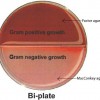 Mastitis is the most common disease in dairy cattle and is estimated to cost dairy farmers $179 a case. When farmers detect clinical mastitis, they usually take immediate action with antibiotics; but many cases either do not need antimicrobial treatment, resolve without treatment, or are not effectively treated by the antimicrobial used. A selective treatment approach can be more effective. This two-step strategy involves first identifying the pathogen, then deciding on a treatment — this would decrease the use of antimicrobials as well as treatment-associated costs for the farmer. This 5-page fact sheet was written by Kathryn Merriman, Fiona Maunsell, Corwin Nelson, and Albert De Vries, and published by the UF Department of Animal Sciences, December 2014. (Photo: University of Minnesota Laboratory for Udder Health, 2004)
Mastitis is the most common disease in dairy cattle and is estimated to cost dairy farmers $179 a case. When farmers detect clinical mastitis, they usually take immediate action with antibiotics; but many cases either do not need antimicrobial treatment, resolve without treatment, or are not effectively treated by the antimicrobial used. A selective treatment approach can be more effective. This two-step strategy involves first identifying the pathogen, then deciding on a treatment — this would decrease the use of antimicrobials as well as treatment-associated costs for the farmer. This 5-page fact sheet was written by Kathryn Merriman, Fiona Maunsell, Corwin Nelson, and Albert De Vries, and published by the UF Department of Animal Sciences, December 2014. (Photo: University of Minnesota Laboratory for Udder Health, 2004)
http://edis.ifas.ufl.edu/an306
Postemergent Herbicides for Use In Ornamentals
 Postemergent herbicides are applied directly to weeds. This 5-page fact sheet is largely comprised of two tables: Table one lists postemergent herbicides that can be safely used over the top of some ornamentals when used according to label directions; table 2 lists postemergent herbicides that are registered for use around ornamental plants when applied as a directed spray. Written by Jeffrey G. Norcini and Chris Marble, and published by the UF Department of Environmental Horticulture, November 2014. (UF/IFAS photo: Thomas Wright)
Postemergent herbicides are applied directly to weeds. This 5-page fact sheet is largely comprised of two tables: Table one lists postemergent herbicides that can be safely used over the top of some ornamentals when used according to label directions; table 2 lists postemergent herbicides that are registered for use around ornamental plants when applied as a directed spray. Written by Jeffrey G. Norcini and Chris Marble, and published by the UF Department of Environmental Horticulture, November 2014. (UF/IFAS photo: Thomas Wright)
http://edis.ifas.ufl.edu/wg059
How to Start a Food Business: Writing a Business Plan
 Before starting a new food business, you should set a goal and have detailed plans to accomplish that goal. But writing a good business plan is often a challenge and it requires a great amount of effort. This 3-page fact sheet provides guidance on how to write a good food-business plan. Written by Soohyoun Ahn, Lisa House, and Renée Goodrich-Schneider, and published by the UF Department of Food Science and Human Nutrition, December 2014. (Photo: iStock/Thinkstock)
Before starting a new food business, you should set a goal and have detailed plans to accomplish that goal. But writing a good business plan is often a challenge and it requires a great amount of effort. This 3-page fact sheet provides guidance on how to write a good food-business plan. Written by Soohyoun Ahn, Lisa House, and Renée Goodrich-Schneider, and published by the UF Department of Food Science and Human Nutrition, December 2014. (Photo: iStock/Thinkstock)
http://edis.ifas.ufl.edu/fs259
The Facts about Mothballs
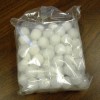 Mothballs, moth flakes, crystals, and bars are insecticides that are formulated as solids. Naphthalene and paradichlorobenzene, the active ingredients in mothballs, are registered as pesticides. As such, their label directions carry the force of the law, including use intent and the sites where they may legally be used. They can harm people, pets, or wildlife that may touch or eat the mothballs or that may breathe the vapors. This 3-page fact sheet was written by Fred Fishel, and published by the UF Department of Agronomy, December 2014.
Mothballs, moth flakes, crystals, and bars are insecticides that are formulated as solids. Naphthalene and paradichlorobenzene, the active ingredients in mothballs, are registered as pesticides. As such, their label directions carry the force of the law, including use intent and the sites where they may legally be used. They can harm people, pets, or wildlife that may touch or eat the mothballs or that may breathe the vapors. This 3-page fact sheet was written by Fred Fishel, and published by the UF Department of Agronomy, December 2014.
http://edis.ifas.ufl.edu/pi254
Carinata Production in Florida
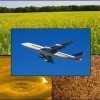 Brassica carinata is a promising oilseed crop with great potential for profitable cultivation in Florida. Its high oil content and favorable fatty acid profile make it suitable for the biofuel industry, especially as a biojet fuel. The UF/IFAS North Florida Research and Education Center (NFREC) in Quincy, Florida, has been working to identify advanced carinata genotypes that are high yielding (seed and oil), disease resistant, early maturing, and adapted to Florida. The work at NFREC is being done in conjunction with Agrisoma Biosciences Inc., a crop company that has the world’s largest collection of carinata germplasm. This 6-page fact sheet’s “Agronomic Management” section provides recommendations resulting from NFREC’s research. was written by C. M. Bliss, R. Seepaul, D. L. Wright, J. J. Marois, R. Leon, N. Dufault, S. George, and S. M. Olson, and published by the UF Department of Agronomy, December 2014.
Brassica carinata is a promising oilseed crop with great potential for profitable cultivation in Florida. Its high oil content and favorable fatty acid profile make it suitable for the biofuel industry, especially as a biojet fuel. The UF/IFAS North Florida Research and Education Center (NFREC) in Quincy, Florida, has been working to identify advanced carinata genotypes that are high yielding (seed and oil), disease resistant, early maturing, and adapted to Florida. The work at NFREC is being done in conjunction with Agrisoma Biosciences Inc., a crop company that has the world’s largest collection of carinata germplasm. This 6-page fact sheet’s “Agronomic Management” section provides recommendations resulting from NFREC’s research. was written by C. M. Bliss, R. Seepaul, D. L. Wright, J. J. Marois, R. Leon, N. Dufault, S. George, and S. M. Olson, and published by the UF Department of Agronomy, December 2014.
http://edis.ifas.ufl.edu/ag389
Producing biochar using a custom designed Top-lit Updraft (TLUD) gasifier
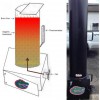 Biochar can be produced in a wide variety of ways; some are complex, while others are relatively simple. Researchers at the University of Florida Everglades Research and Education Center in Belle Glade, FL, designed and built a top-lit updraft (TLUD) gasifier that can generate biochar from locally acquired feedstock. This 4-page fact sheet describes its design and evaluates the biochar recovery of four locally available feedstocks. Written by Jehangir H. Bhadha, Stephen Jennewein, Julio Sanchez, and Timothy A. Lang, and published by the UF Department of Soil and Water Science, September 2014.
Biochar can be produced in a wide variety of ways; some are complex, while others are relatively simple. Researchers at the University of Florida Everglades Research and Education Center in Belle Glade, FL, designed and built a top-lit updraft (TLUD) gasifier that can generate biochar from locally acquired feedstock. This 4-page fact sheet describes its design and evaluates the biochar recovery of four locally available feedstocks. Written by Jehangir H. Bhadha, Stephen Jennewein, Julio Sanchez, and Timothy A. Lang, and published by the UF Department of Soil and Water Science, September 2014.
http://edis.ifas.ufl.edu/ss626
Techniques for Melon Grafting
Grafting as a cultural practice for controlling soilborne diseases and improving abiotic stress tolerance has been widely used in vegetable production in many areas of Asia and Europe. Interest in vegetable grafting has been growing in the United States in recent years, as well. Cost, along with the desire to customize scion cultivars and the need to produce organic transplants, has led many small and organic growers to choose to graft plants by themselves. To help growers who are interested in grafting melon plants achieve a high graft survival rate, this 5-page fact sheet introduces commonly used grafting techniques and their application in specific circumstances. Written by Wenjing Guan and Xin Zhao, and published by the UF Department of Horticultural Sciences, December 2014.
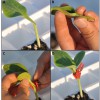 fl.edu/hs1257>http://edis.ifas.ufl.edu/hs1257
fl.edu/hs1257>http://edis.ifas.ufl.edu/hs1257
Best Management Practices for Siting Honey Bee Colonies: Good Neighbor Guidelines
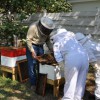 Keeping honey bees requires responsible management so that the bees do not become a nuisance. Additionally, the presence of Africanized honey bees in Florida places more pressure on beekeepers to maintain their colonies properly. This 3-page fact sheet is a reference for honey bee management in Florida, with emphasis on siting apiaries in sensitive locations, in order to promote harmonious cooperation between beekeepers, neighbors, and landowners. Written by Jamie Ellis, Jerry Hayes, and published by the UF Department of Entomology and Nematology, November 2014. (Photo by Thien Gretchen (CC BY-NC-ND 2.0), via Flickr)
Keeping honey bees requires responsible management so that the bees do not become a nuisance. Additionally, the presence of Africanized honey bees in Florida places more pressure on beekeepers to maintain their colonies properly. This 3-page fact sheet is a reference for honey bee management in Florida, with emphasis on siting apiaries in sensitive locations, in order to promote harmonious cooperation between beekeepers, neighbors, and landowners. Written by Jamie Ellis, Jerry Hayes, and published by the UF Department of Entomology and Nematology, November 2014. (Photo by Thien Gretchen (CC BY-NC-ND 2.0), via Flickr)
http://edis.ifas.ufl.edu/aa137
Frequently Asked Questions about the Africanized Honey Bee in Florida
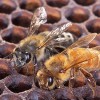 The African honey bee, Apis mellifera scutellata, was introduced into South America from the central and southern part of Africa in 1957. Since its introduction into South America, the African bee has migrated into the southwestern United States and Florida. Apis mellifera scutellata is the African bee subspecies referred to in this 3-page fact sheet, which answers commonly asked questions about these bees and their behavior. Written by M. K. O’Malley, J. D. Ellis and A. S. Neal, and published by the UF Department of Entomology and Nematology, November 2014.
The African honey bee, Apis mellifera scutellata, was introduced into South America from the central and southern part of Africa in 1957. Since its introduction into South America, the African bee has migrated into the southwestern United States and Florida. Apis mellifera scutellata is the African bee subspecies referred to in this 3-page fact sheet, which answers commonly asked questions about these bees and their behavior. Written by M. K. O’Malley, J. D. Ellis and A. S. Neal, and published by the UF Department of Entomology and Nematology, November 2014.
http://edis.ifas.ufl.edu/in738
Pest Identification Guides
Created to help growers and crop consultants, private homeowners, Master Gardeners, and the general public identify common arthropod pests and the damage they inflict, each field guide provides photos of the important life stages and crop damage associated with arthropod pests. The text highlights key general morphology and biology, distribution, and natural enemies. Written by Nicole Casuso and Hugh Smith, and published by the UF Department of Entomology and Nematology, October 2014.
http://edis.ifas.ufl.edu/topic_series_pest_identification_guides
Genetically Modified Food
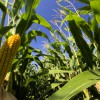 A food is considered genetically modified when its genetic makeup is altered in some way as a result of the use of recombinant DNA biotechnological procedures. These changes result in the expression of attributes not found in the original. Examples include delayed-ripening tomatoes and pest-resistant or herbicide-tolerant crops. Genetic modification can be used to improve crop yields, reduce insecticide use, or increase the nutritional value of foods. This 5-page fact sheet answers questions consumers might have about genetically modified food. Written by Keith R. Schneider, Renée Goodrich Schneider, and Susanna Richardson, and published by the UF Department of Food Science and Human Nutrition, November 2014. (Photo: iStock/Thinkstock.com)
A food is considered genetically modified when its genetic makeup is altered in some way as a result of the use of recombinant DNA biotechnological procedures. These changes result in the expression of attributes not found in the original. Examples include delayed-ripening tomatoes and pest-resistant or herbicide-tolerant crops. Genetic modification can be used to improve crop yields, reduce insecticide use, or increase the nutritional value of foods. This 5-page fact sheet answers questions consumers might have about genetically modified food. Written by Keith R. Schneider, Renée Goodrich Schneider, and Susanna Richardson, and published by the UF Department of Food Science and Human Nutrition, November 2014. (Photo: iStock/Thinkstock.com)
http://edis.ifas.ufl.edu/fs084
Environmental Impact of Beef Cattle Production Systems
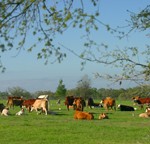 This 6-page fact sheet discusses beef demand in the context of a growing population, beef production’s greenhouse gases and their effect on the environment, the great advantage of ruminants, generating accurate greenhouse gas emissions estimates, greenhouse gas emissions by economic sector, and mitigation strategies. Written by Nicolas DiLorenzo, G. Cliff Lamb, Jose Dubeux, John Arthington, Joao Vendramini, and Phillip Lancaster and published by the UF/IFAS Department of Animal Sciences, November 2014. (UF/IFAS Photo by Thomas Wright)
This 6-page fact sheet discusses beef demand in the context of a growing population, beef production’s greenhouse gases and their effect on the environment, the great advantage of ruminants, generating accurate greenhouse gas emissions estimates, greenhouse gas emissions by economic sector, and mitigation strategies. Written by Nicolas DiLorenzo, G. Cliff Lamb, Jose Dubeux, John Arthington, Joao Vendramini, and Phillip Lancaster and published by the UF/IFAS Department of Animal Sciences, November 2014. (UF/IFAS Photo by Thomas Wright)
http://edis.ifas.ufl.edu/an302
Is My Tree Safe? Recognizing Conditions that Increase the Likelihood of Tree Failure
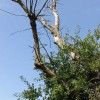 Urban trees provide shade and beauty and the urban forest as a whole provides a wealth of benefits to neighborhoods and residents. But stresses from the urban environment may lead to problems that pose an unacceptable safety risk to people and property. It is a landowner’s responsibility to ensure that the trees on their property are safe. A key step in reducing the potential for tree-related injury or property damage is learning to identify common tree defects associated with increased risk of failure. This 5-page fact sheet highlights seven easily reconizable tree defects that homeowners and non-professionals in public agencies. may encounter in Florida. Written by Drew C. McLean, Andrew K. Koeser, Robert J. Northrop, and Gitta Hasing, and published by the UF Department of Environmental Horticulture, October 2014. (Photo by Gitta Hasing)
Urban trees provide shade and beauty and the urban forest as a whole provides a wealth of benefits to neighborhoods and residents. But stresses from the urban environment may lead to problems that pose an unacceptable safety risk to people and property. It is a landowner’s responsibility to ensure that the trees on their property are safe. A key step in reducing the potential for tree-related injury or property damage is learning to identify common tree defects associated with increased risk of failure. This 5-page fact sheet highlights seven easily reconizable tree defects that homeowners and non-professionals in public agencies. may encounter in Florida. Written by Drew C. McLean, Andrew K. Koeser, Robert J. Northrop, and Gitta Hasing, and published by the UF Department of Environmental Horticulture, October 2014. (Photo by Gitta Hasing)
http://edis.ifas.ufl.edu/ep507
Potential Bull Buyers Perceive Increased Value to their Operations When Purchasing Bulls from the Florida Bull Test
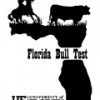 Since its beginning in 2000, the Florida Bull Test has been under constant evolution to achieve its goal of helping producers select high-quality sires, thereby improving production and profitability of beef cattle producers in Florida and the Southeast United States. A survey of potential buyers before the 2014 sale succeeded in identifying which characteristics of bulls are most important to buyers purchasing bulls: purchasing bulls from the Florida Bull Test increases the value of calves sired by improving performance, genetics, and feed efficiency of their herds. This 3-page fact sheet was written by Vitor R. G. Mercadante, Darren D. Henry, Francine M. Ciriaco, Paula M. Mercadante, Tessa Schulmeister, Nicolas DiLorenzo, and G. Cliff Lamb, and published by the UF Department of Animal Sciences, November 2014.
Since its beginning in 2000, the Florida Bull Test has been under constant evolution to achieve its goal of helping producers select high-quality sires, thereby improving production and profitability of beef cattle producers in Florida and the Southeast United States. A survey of potential buyers before the 2014 sale succeeded in identifying which characteristics of bulls are most important to buyers purchasing bulls: purchasing bulls from the Florida Bull Test increases the value of calves sired by improving performance, genetics, and feed efficiency of their herds. This 3-page fact sheet was written by Vitor R. G. Mercadante, Darren D. Henry, Francine M. Ciriaco, Paula M. Mercadante, Tessa Schulmeister, Nicolas DiLorenzo, and G. Cliff Lamb, and published by the UF Department of Animal Sciences, November 2014.
http://edis.ifas.ufl.edu/an313
Understanding Pregnancy Diagnosis in Beef Cattle
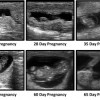 Because 55 to 70 percent of the input costs associated with a beef cattle operation are related to nutrition, culling open (non-pregnant) cows after the breeding season can save as much as $200 per head that can be diverted to the purchase or development of replacement females, sire selection, increased nutritional management, and other management-related costs. Pregnancy diagnosis can be performed simply during vaccination or at the time of weaning. There are three practical methods: rectal palpation, transrectal ultrasonography, or blood test. This 5-page fact sheet was written by G. Cliff Lamb, Darren D. Henry, Vitor R. G. Mercadante, and Doug E. Mayo, and published by the UF Department of Animal Sciences, November 2014.
Because 55 to 70 percent of the input costs associated with a beef cattle operation are related to nutrition, culling open (non-pregnant) cows after the breeding season can save as much as $200 per head that can be diverted to the purchase or development of replacement females, sire selection, increased nutritional management, and other management-related costs. Pregnancy diagnosis can be performed simply during vaccination or at the time of weaning. There are three practical methods: rectal palpation, transrectal ultrasonography, or blood test. This 5-page fact sheet was written by G. Cliff Lamb, Darren D. Henry, Vitor R. G. Mercadante, and Doug E. Mayo, and published by the UF Department of Animal Sciences, November 2014.
http://edis.ifas.ufl.edu/an314